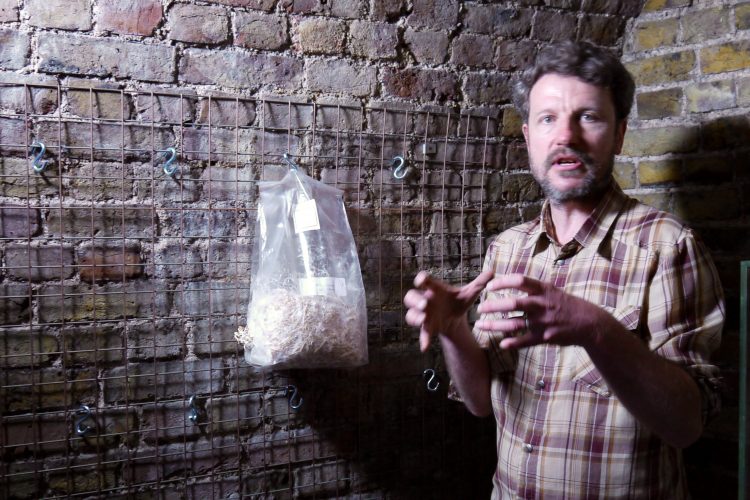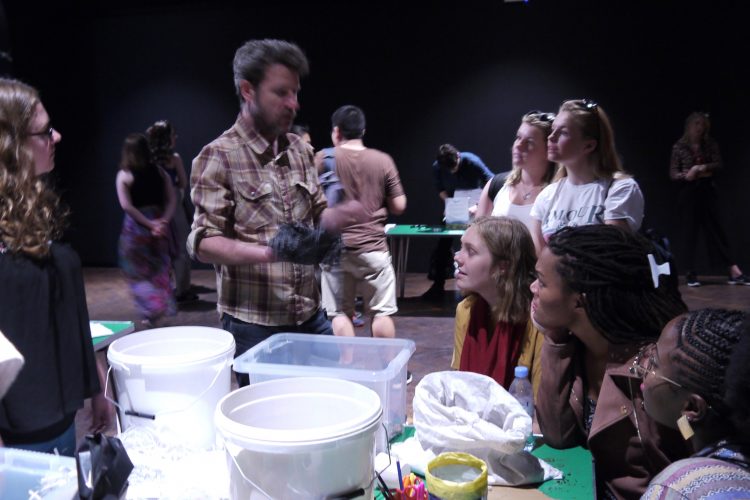How to make a wormery in the midst of concrete buildings
Published 5 June 2018 by Elsa Ferreira
A collective of English gardener-artists set up a cooperative at Somerset House and are growing vegetables in the dark, between concrete and tarmac. In order to counter this hostile environment, nothing beats good compost. Tutorial.
London, from our correspondent
Worms are astounding animals. “We owe them our landscape, explains Tim Mitchell, co-founder of Edible Utopia, an artistic cooperative that has just settled in Somerset House, a cultural institution in London. They create the environment for plants. Without plants, no animals nor humans. They are our guardian angels.” Voracious guardian angels that transform dead matter coming down from the surface before mixing it with minerals to create a fertile environment. On top of being excellent soil fertilizers, worms regulate themselves: “When their numbers grow too much, they slow down their reproduction.” Handy, when you breed in an enclosed environment.
Edible Utopia moved to Somerset last March, under the impulsion of five researchers, artists, gardeners and a mycologist. They made their debuts within the institution in 2016, where programmers were celebrating utopia and the 500th anniversary of Thomas More’s book, Utopia, founding work of utopian thought.
The group then put together an ambitious project: studying the opportunity of agriculture within Somerset, a building where concrete and stone cover each plot. “It’s a hostile environment for food and nature,” recognizes Tim Mitchell. They have already planted rhubarb with residents of the institution. They set up their wormery in the basements of the building that in the old days sheltered coal cellars. They will produce compost for vegetables and a mushroom farm that they feed amongst other things with coffee grounds from the Somerset restaurant.

The collective also plans to grow vegetables in the dark, to “turn constraints into assets”. The process already exists but the artists are organizing a certain level of experimentation. “With a bit of luck, we will make discoveries.” The objective: a zero kilometer food cycle, where vegetables would be served in the restaurant and their residue turned into compost to grow the next crop.
Gastrosophy or wisdom
The collective finds inspiration from Charles Fourier, French philosopher (1772-1837), creator of “gastrosophy” or “stomach wisdom”, explains Jane Levi, co-founder and food historian. “Gastrosophy is Fourier’s answer to gastronomy, which he said was superficial and all about people being encouraged to spend a lot of money and eat too much and not understand their own taste but allow people to tell them about their own taste and what is good.” Fourier said “Only you know what’s good. Everyone has their own taste. So you should cultivate it. Good taste is your own taste properly cultivated.”
An approach based on knowledge and DIY: “There is no point in you saying you like asparagus if you don’t know how to grow them, recognize the different varieties and cook them in fifteen different ways,” explains Jane Levi. Also based on sharing. “According to his gastrosophy concept, you can’t think about each step in isolation. You are only achieving something meaningful for society and building a community if you are putting together the soil, the growing, the cooking and the eating into one holistic process that you are sharing with other people.” Eventually, Edible Utopia would like to transform some of its vegetables during workshops (jam, preserves…) and organize a giant feast in the Somerset House courtyard.
As for the worms, they are already at work. During Earth Day in April, Tim Mitchell and visitors built boxes to welcome the creatures. Here is the tutorial.

Equipment
– A container such as a medium-sized rubbish bin or a deep apple box with a lid;
– A water-butt tap;
– A small piece of wire mesh or nylon material;
– A short twist of wire or nylon string;
– A piece of thick polythene for use as the membrane (an old compost bag is ideal, as it won’t break down in the same way as rubbish bags or shopping bags);
– A bucket of gravel;
– Compost from a compost heap, or well-rotted leafmould (composted leaves) mixed with garden soil;
– At least 500 red, tiger or brandling worms.
Steps
– Drill a hole to accommodate the tap as close to the base of the container as the construction of the container will allow;
– Ensure that you have a good seal around the tap;
– Place a piece of material cut from a pair of nylon tights or a piece of wire mesh around the tap where it protrudes into the bin to act as a filter;
– Drill a series of air holes about 9cm (31⁄2 in) apart, just under the rim of the lid;
– Fill the bottom of your bin with 9cm (31⁄2 in) of gravel;
– Cut the plastic sheet so it fits neatly over the layer of gravel and slightly up the sides of the bin to prevent worms from falling or burrowing down into the sump;
– Poke plenty of tiny drainage holes through the plastic to allow the worm leachate to drain through and collect in the gravel beneath;
– Put a 9cm (31⁄2 in) layer of compost and garden soil mix on top of the plastic. Put your worms on this and cover with another 2–3cm (3⁄4–11⁄4 in) of soil to bed them in;
– Place about 1 liter (13⁄4 pints) of kitchen waste on the compost and cover it with several layers of wet (but not dripping) newspaper, then replace the lid and leave your worms to make themselves at home for 2 weeks.
Instructions for use
From then on, keep adding kitchen scraps whenever the last scraps have been used up and replace the protective blanket of damp newspaper whenever it rots down. “Worms work best when they are comfortable, so place your wormery in an easily accessible sheltered area out of direct sunlight, and give it extra protection in winter,” advises Edible Utopia.
After about 2 months they will be up to speed and chomp away on your kitchen waste with enthusiasm.
Tim Mitchell’s full tutorial, Edible Utopia (PDF)
